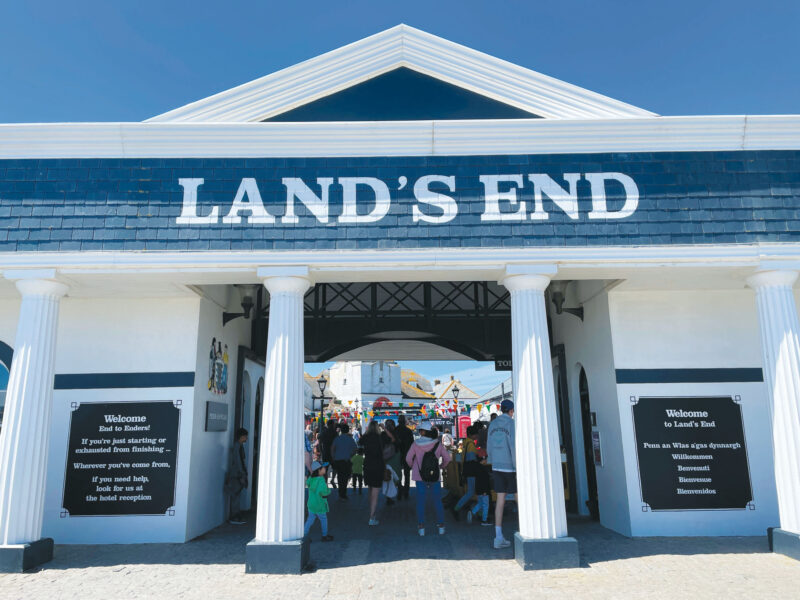When you arrive at Land’s End, there’s no mistaking where you are, and yet you cannot see it. What you can see—at this southwesternmost tip of England, this cliff-edge of Britannia, where the Cornwall peninsula claws into the Celtic Sea—is a parking lot.
Then you can see the words land’s end emblazoned on an enormous Doric-columned entrance, the width of a four-lane highway, beside which the open-topped Land’s End Coaster deposits busloads of tourists. Then you can see Land’s End doughnuts, and Land’s End ice cream, and the boots of a man who walked naked from Land’s End to the north tip of Great Britain. You can see Land’s End teddy bears, and Land’s End stuffed octopuses, and Land’s End pillows shaped like giant Cornish pasties, the famous thick-crusted savory tarts once meant for miners to eat underground and now among the region’s biggest exports.
You can see an immersive journey into the legend of King Arthur, replete with fire-breathing dragons and the “latest interactive technology.” And a “4D Film Experience,” in which you plot your escape from a ship of swashbuckling pirates. And you can see families waiting in line to be photographed beneath the “iconic” land’s end signpost, which indicates that New York City is 3,147 miles away, and which has a customizable slot for your name and the distance you are from your own hometown (the blandfords, broadbottom: 344 miles).
So what is it you cannot see? In this place that bellows its name from every direction, it is easy to forget where you are. Behind the souvenirs and the cinemas, the fast food and the flashing lights, that which actually surrounds you—windswept headlands, weather-sculpted cliffs rising high above wild waves, razorbills and sea campion and basking sharks—has been disciplined into a backdrop.
This other Land’s End is hidden in the strata of its 270-million-year-old granite cliffs, in the shifting edges of its shoreline. It’s a place that for millennia has stirred, with its raw beauty, its epic position, a deep sense of the sublime: that exalted, terrifying greatness (“mingled with Horrours, and sometimes almost with despair,” wrote John Dennis). The ancient Greeks deemed it Belerion—the place of the sun—and in its shining aura, Bronze Age peoples laid sacred stone circles and buried their dead. When its Cornish name, Penwith Steort, meaning “extreme end,” came into use in 997 CE, it captured the spiritual potency of a place at the outermost reaches, with its ragged border between land and sea, known and unknown. Crossing such a boundary, in Celtic mythology, is a way into the Otherworld. After the end, a beginning. As poet Henry Alford characterized these cliffs in 1860: “Look out upon the glorious realms of hope, / And find the last of earth,—the first of God.”
This Land’s End—of poetry, of worship, of extra-human sublimity—is hard to find, smothered as it is by tourist paraphernalia, a shopping mall at the end of the world. The man-made version of Land’s End, while trying to fulfill a consumerist notion of what befits such an endpoint, ignores the soul of the place, that which drew us to it to begin with. In a sense, it’s the inverse of László Krasznahorkai’s story of a man who goes to the Acropolis but is unable to see this wonder of Western civilization for what it is, because he’s completely blinded by the summer sun. “He was never even going to see the Acropolis, even though he was here at the Acropolis,” he laments. In the natural wonder that is Land’s End, it is our own human-made materialism that blinds us to it.
This is, of course, a phenomenon of our time, the self-destructive compulsion to shut our eyes and drain the earth for our fleeting desires (pipelines in old-growth forests, mountains bombed for bauxite, et cetera, et cetera). But in Land’s End, a place whose very name conjures something beyond comprehension, something greater than us, there is a crystalline object lesson in the cognitive dissonance between what we’ve made and what we’re obscuring—what we need to retrieve.





